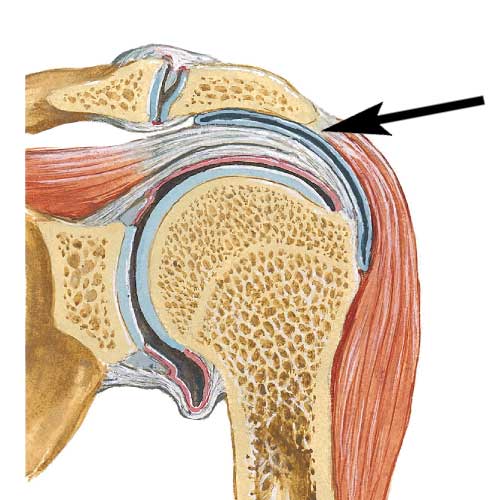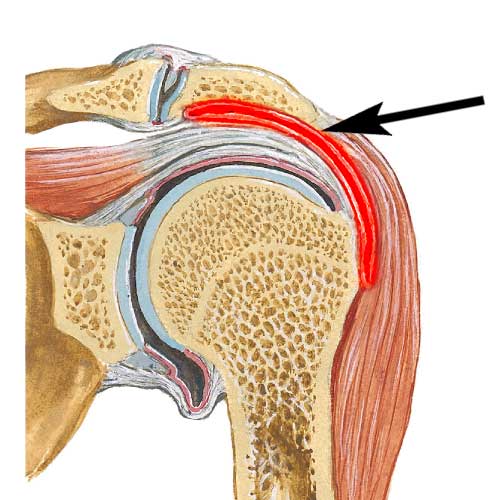Shoulder Bursitis Treatment
- Shoulder bursitis or impingement leads to pinching of your shoulder muscles
- Shoulder impingement can lead to shoulder pain, weakness and stiffness
- There are several non-operative ways to treat shoulder bursitis
- If your shoulder is not improving & you have persistent shoulder pain & weakness, you may need surgery
- Surgery for shoulder bursitis or shoulder decompression surgery is done arthroscopically (key-hole)
- Recovery after shoulder decompression surgery can take 6-12 weeks
What is shoulder bursitis & impingement?
Shoulder impingement, also known as subacromial impingement or shoulder bursitis, is caused by compression or pinching of the rotator cuff tendons and soft tissues at the top of your shoulder against the top of the shoulder blade. It occurs when there is reduced space between the acromion (a bony projection of the shoulder blade) and the rotator cuff tendons and bursa (fluid-filled sac that acts as a cushion at the top of the shoulder). This compression can lead to pain, inflammation and limited range of motion.
The main reasons why your shoulder may develop shoulder impingement include:
Structural factors: Certain anatomical variations, such as a bony outgrowth of your acromion, also known as a hooked acromion, a downward-pointing acromion, or a generally narrow space beneath the acromion, can cause shoulder impingement. However, the main diving factor for shoulder impingement is inflammation or injury of the rotator cuff. The rotator cuff consists of four muscles and their tendons that encircle the shoulder joint. The rotator cuff provides stability to your shoulder and helps your shoulder move.
- Repetitive overhead activities: Activities that involve repetitive overhead motions or excessive use of the shoulder joint can contribute to the development of shoulder impingement. This main include continuous work exposure, throwing, lifting heavy objects or taking part in specific sports.
- Muscle imbalances and weakness: Imbalances in the muscles surrounding the shoulder joint and your shoulder blade (scapula) can lead to abnormal movement. This is can change the way your shoulder sits at rests against your chest wall and how it moves. This, in turn, can increase the risk of of shoulder impingement.
How do you know if you have shoulder bursitis?
The symptoms of shoulder impingement can vary depending on why you have developed shoulder impingement. Most commonly, you may have pain at the tip of the shoulder with shoulder abduction (moving the arm away from your body). Common symptoms you may experience include:
- Pain: Typically felt at the tip or the front of the shoulder. Your pain may get worse with shoulder activity, especially with moving your shoulder above your head. Sometimes you can also have persistent pain with prolonged sitting. In some cases, your pain could also persist throughout the night and make finding a comfortable position in bed difficult.
- Weakness: Difficulty or weakness in performing certain shoulder movements or lifting objects can be part of shoulder impingement. This is particularly the case if the underlying case of impingement is a tear in your rotator cuff tear. You may find that lifting objects or certain movements or sports are tricky to do.
- Limited range of motion: Reduced ability to move your shoulder usually gives hand in hand with pain and weakness. This is particularly the case with activities involving abduction (raising the arm to the side) and external rotation (rotating the arm outward) of your shoulder.
Can shoulder bursitis and impingement be reversed?
Patients frequently ask “Will my shoulder impingement ever go away?” or “Can shoulder impingement be reversed?”. The answer to those questions is frequently not straight forward. This is because the reasons why you may have shoulder impingement are often multi-factorial. You may have developed impingement due to an injury, altered scapular movement, posture, torn muscles or tendons, calcific tendonitis, degeneration or other causes. There are however some things that can be done to treat your pain and improve your shoulder function.
How is Shoulder Bursitis Treated?
The majority of shoulder impingement (around 80%) can be effectively treated without surgery. Everyone’s shoulder and expectations are different, so there is no one thing that works best. Treatment should be tailored to your specific needs. Broadly, the best way to treat shoulder impingement is to combine treatments. Research has shown that when you use different treatment modalities concurrently, the benefits are much larger than just sticking to one thing. Some of the options are outlined below:
- Rest and activity modification: This is a good starting point. Avoiding or modifying activities that worsen your pain can help you to manage your symptoms temporarily. You may find that wearing a shoulder sling can help.
- Pain management: It is best to stick to simple pain relief, such as Paracetamol (Panadol) or nonsteroidal anti-inflammatories (NSAIDs; Neurofen). Steroid injections can also be used to reduce pain and inflammation
- Exercises: Physiotherapy can help to strengthen and regain function. A dedicated physiotherapist would usually work with you by targeting the five pillars of shoulder rehabilitation: (1) Heating and/or cooling, (2) Massage and manual therapy, (3) Range of motion work, (4) Flexibility as well as stretching and (5) strengthening. Your physiotherapist may also suggest shoulder taping, which could help you to restore normal shoulder dynamics.
- Acupuncture/ Dry Needling: Some patients may see benefit from acupuncture. The main therapeutic effect from this is from activation of sensory receptors. This can stimulate your central nervous system to naturally produce pain killers (endogenous opioid peptides), leading to reduction of pain.
- Extracorporeal Shockwave Therapy: This involves application of high-energy acoustic waves to your shoulder. It can promote your body to start a healing or repair process. This may particularly be beneficial if the reason you have shoulder impingement is due to extensive inflammation of your rotator cuff, such as calcific tendonitis.
- Laser therapy: This is also known as cold laser or low-level laser therapy. It uses a specific type of light that may help to promote healing and inhibit pain naturally.
Do I need shoulder decompression surgery?
In some cases, surgery on your shoulder may be necessary, sometimes known as shoulder decompression surgery. If you have tried several non-operative treatments and are still experiencing pain and limited use of your shoulder, it is best to have your shoulder assessed by a specialist. Surgery is done arthroscopically (key-hole) and is aimed at creating more space in the shoulder joint by removing any bone spurs or any excess inflammation. In addition, if the reason you have continued shoulder impingement is damage or injury to your rotator cuff, surgery may be better suited at treating this rather than persisting with non-surgical treatment.
Get Expert Help
Symptoms with shoulder bursitis or impingement can vary from patient to patient. If you are experiencing shoulder pain, limited mobility, or other concerning symptoms, it is best to be seen by a shoulder surgeon. Dr Arthur Turow is an Australian trained shoulder surgeon based in Adelaide. He can assess your shoulder, provide you with an accurate diagnosis and suggest tailored treatment options specific for your individual needs.
Please use above information as a guide only. More detailed information specific to your condition and your recovery will be given in your consultation with Dr. Arthur Turow, who will also provide additional resources to supplement your discussion. For more information, please contact the rooms of Dr. Arthur Turow on (08) 8236 4179.




